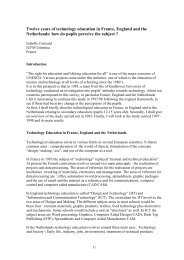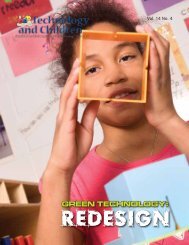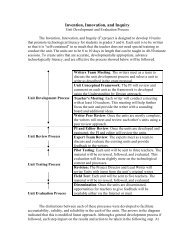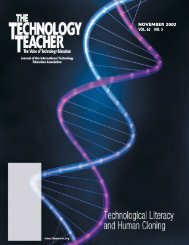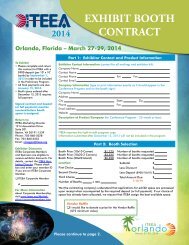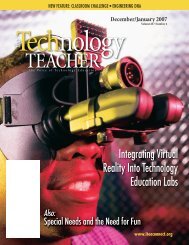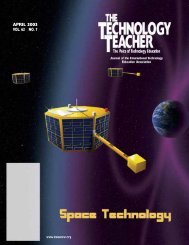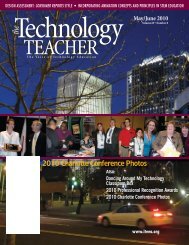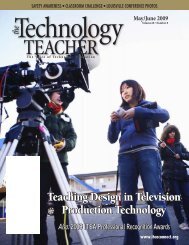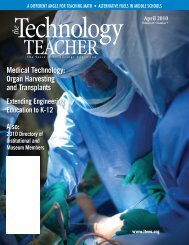October 2004 - Vol 64, No.2 - International Technology and ...
October 2004 - Vol 64, No.2 - International Technology and ...
October 2004 - Vol 64, No.2 - International Technology and ...
- No tags were found...
You also want an ePaper? Increase the reach of your titles
YUMPU automatically turns print PDFs into web optimized ePapers that Google loves.
FEATURE ARTICLENorth Carolina, Virginia, Utah, <strong>and</strong>Wisconsin. The final CATTS state,Maryl<strong>and</strong>, is in the process of presentingst<strong>and</strong>ards based on STL to thestate board of education for approval.The companion st<strong>and</strong>ards to STL,which were published by ITEA in 2003in a document entitled AdvancingExcellence in Technological Literacy:Student Assessment, ProfessionalDevelopment, <strong>and</strong> Program St<strong>and</strong>ards(AETL), show less usage than STL. InResponse to Question 5, AETL usagewas reported by 22 states (42.3%).Twenty-three states (44.2%) are notusing AETL yet. The differencebetween STL <strong>and</strong> AETL usage is notunexpected, considering AETL hadbeen published one year prior to thetime the survey was conducted. Fourstates—Florida, Georgia, Indiana, <strong>and</strong>North Carolina—commented on theneed for implementation proceduresfor AETL. Comments also revealedthat, at the state level, the professionaldevelopment st<strong>and</strong>ards in AETLwere of particular use.Conclusions/DiscussionThe increase in the number of statesthat include technology education inthe state framework may indicate that,as a nation, we are placing increasingimportance on technology educationas part of the overall learning experience.This trend is likely instigated byresearch on the increasing need for atechnologically literate populace.(ITEA, 1996; ITEA 2000/2002; ITEA2003; NAE & NRC, 2002; Rose &Dugger, 2002; Rose, Gallup, Dugger, &Starkweather, <strong>2004</strong>.)YesNoUnknownNo ResponseNo AnswerSTLUsed?<strong>2004</strong>417211Requiring technology education isanother issue, however. While nearlya quarter of the nation requires technologyeducation in some way, <strong>and</strong> theother three-quarters of the nation offerit as an elective or leave the decisionto localities or districts, the methodused to deliver technology educationvaries considerably. While conclusivedata is not available, comments indicatethat some states offer technologyeducation as a separate subject, onedesigned to deliver technological literacy.Other states embed technologicalliteracy concepts into the curriculumof other core subject areas, such asscience. And still other states providetechnology education as part of acareer <strong>and</strong> technical context.While NCLB does not identify technologyeducation as a subject area, itdoes require technology literacy—sometimes referred to interchangeablyin U.S. Department of Educationdocuments as technological literacy—forall students by 2006.However, NCLB does not define preciselywhat technology/technologicalliteracy means. The Partnership for21 st Century Skills, which broughttogether educators, administrators,parents, businesses, <strong>and</strong> communityleaders to define twenty-first centuryskills, has been building a consensualdefinition of what technology/technologicalliteracy means. Information onthe Partnership can be found online atwww.21stcenturyskills.org. The U.S.Department of Education is identifiedas a key partner of this group, <strong>and</strong>discussions with the Office ofEducational <strong>Technology</strong> reveal thatthe U.S. Department of Education isvery much interested in a definitionthat extends beyond informational/STLUsed?2003*437000AETLUsed?<strong>2004</strong>2223511Table 1: Summary of <strong>2004</strong> ITEA-TfAAP Study <strong>and</strong> 2003 Ndahi & Ritz Report on theusage of national technological literacy st<strong>and</strong>ards in the United States.educational technology alone <strong>and</strong>includes relevance to such things asagriculture, medicine, manufacturing,<strong>and</strong> construction, much like the definitionin STL. For example, a math <strong>and</strong>science initiative is underway toexamine how a broader definition oftechnological literacy can be deliveredin the classroom.Hence, it appears that the intent ofNCLB m<strong>and</strong>ates for technology/technologicalliteracy are very much in linewith the vision for technological literacydefined in STL. It remains to beseen, however, whether implementationof NCLB m<strong>and</strong>ates will focus,through a lack of awareness, on information<strong>and</strong> communication technologyalone. And while aspects of technologicalliteracy can <strong>and</strong> should bedelivered through mathematics, science,<strong>and</strong> other core subject classrooms,full implementation of thest<strong>and</strong>ards in STL is unlikely throughembedded curricula at the secondarylevel. <strong>Technology</strong> education is the onlysubject area specifically designed todeliver technological literacy.Identifying technology education as acore subject area—<strong>and</strong> therefore arequirement for graduation—is oneway to ensure that all students willbecome technologically literate asintended by NCLB <strong>and</strong> STL. Such adistinction would also ensure that32 <strong>October</strong> <strong>2004</strong> • THE TECHNOLOGY TEACHER



